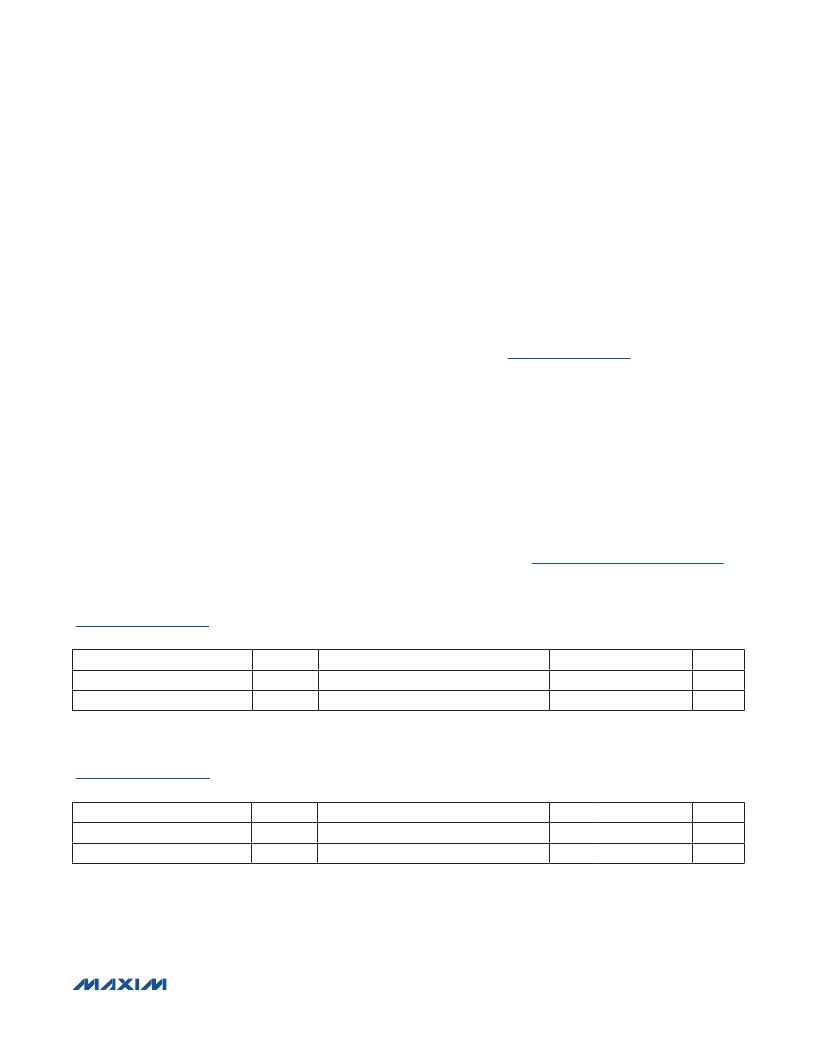- 您现在的位置:买卖IC网 > Sheet目录471 > MAX2042AETP+T (Maxim Integrated)IC UP/DWN CONVERSION MIXR 20TQFN

MAX2042A
SiGe High-Linearity, 1600MHz to 3900MHz
Upconversion/Downconversion Mixer with LO Buffer
ABSOLUTE MAXIMUM RATINGS
V CC to GND..........................................................-0.3V to +5.5V
IF+, IF-, LOBIAS to GND ......................... -0.3V to (V CC + 0.3V)
RF, LO Input Power ....................................................... +20dBm
IF Input Power (50ω source) ......................................... +18dBm
RF, LO Current (RF and LO are DC shorted to
GND through a balun) ....................................................50mA
Operating Case Temperature Range (Note 1) ....... -40 N C to +85 N C
Continuous Power Dissipation (Note 2) ..............................5.0W
Junction Temperature .....................................................+150 N C
Storage Temperature Range............................ -65 N C to +150 N C
Lead Temperature (soldering 10s) .................................+300 N C
Soldering Temperature (reflow) ......................................+260 N C
Note 1: T C is the temperature on the exposed pad of the package. T A is the ambient temperature of the device and PCB.
Note 2: Based on junction temperature T J = T C + ( B JC x V CC x I CC ). This formula can be used when the temperature of the
exposed pad is known while the device is soldered down to a PCB. See the Applications Information section for details.
The junction temperature must not exceed +150 N C.
Stresses beyond those listed under “Absolute Maximum Ratings” may cause permanent damage to the device. These are stress ratings only, and functional opera-
tion of the device at these or any other conditions beyond those indicated in the operational sections of the specifications is not implied. Exposure to absolute
maximum rating conditions for extended periods may affect device reliability.
PACKAGE THERMAL CHARACTERISTICS
TQFN
Junction-to-Ambient
Thermal Resistance B JA (Notes 3, 4) ....................... +38°C/W
Junction-to-Case
Thermal Resistance B JC (Notes 2, 4) ....................... +13°C/W
Note 3: Junction temperature T J = T A + ( B JA x V CC x I CC ). This formula can be used when the ambient temperature of the PCB is
known. The junction temperature must not exceed +150 N C.
Note 4: Package thermal resistances were obtained using the method described in JEDEC specification JESD51-7, using a four-
layer board. For detailed information on package thermal considerations, refer to www.maxim-ic.com/thermal-tutorial .
5.0V SUPPLY DC ELECTRICAL CHARACTERISTICS
( Typical Application Circuit , V CC = 4.75V to 5.25V, no input AC signals. T C = -40 N C to +85 N C, unless otherwise noted. Typical values
are at V CC = 5.0V, T C = +25 N C.)
PARAMETER
Supply Voltage
Supply Current
SYMBOL
V CC
I CC
CONDITIONS
MIN
4.75
TYP
5
140
MAX
5.25
162
UNITS
V
mA
3.3V SUPPLY DC ELECTRICAL CHARACTERISTICS
( Typical Application Circuit , V CC = 3.0V to 3.6V, no input AC applied. T C = -40 N C to +85 N C, unless otherwise noted. Typical values
are at V CC = 3.3V, T C = +25 N C.)
PARAMETER
Supply Voltage
SYMBOL
V CC
CONDITIONS
MIN
3.0
TYP
3.3
MAX
3.6
UNITS
V
Supply Current
I CC
122
mA
????????????????????????????????????????????????????????????????? Maxim Integrated Products 4
发布紧急采购,3分钟左右您将得到回复。
相关PDF资料
MAX2042ETP+T
IC MIXER UP/DOWN CONVER 20TQFN
MAX2043ETX+
IC BASE STATION HI LIN 36-TQFN
MAX2043EVKIT
EVAL KIT FOR MAX2043
MAX2044ETP+T
IC MIXER UP/DOWN CONVER 20TQFN
MAX2046ETJ+T
IC MULT HI GAIN VECTOR 32-TQFN
MAX2047EVKIT
EVAL KIT FOR MAX2047
MAX2051ETP+T
IC UP/DOWNCONVERSION MIXR 20TQFN
MAX2055EUP+TD
IC ADC DRVR/AMP VAR GAIN 20TSSOP
相关代理商/技术参数
MAX2042AETT
制造商:MAXIM 制造商全称:Maxim Integrated Products 功能描述:SiGe High-Linearity, 1600MHz to 3900MHz Upconversion/Downconversion
MAX2042AEVKIT+
功能描述:射频混合器 MAX2042A EVKIT RoHS:否 制造商:NXP Semiconductors 频率范围: 转换损失——最大: 工作电源电压:6 V 最大工作温度:+ 85 C 最小工作温度:- 40 C 安装风格:Through Hole 封装 / 箱体:PDIP-8 封装:Tube
MAX2042ETP+
功能描述:射频混合器 2GHz-3GHz Up/Down Mixer RoHS:否 制造商:NXP Semiconductors 频率范围: 转换损失——最大: 工作电源电压:6 V 最大工作温度:+ 85 C 最小工作温度:- 40 C 安装风格:Through Hole 封装 / 箱体:PDIP-8 封装:Tube
MAX2042ETP+T
功能描述:射频混合器 2GHz-3GHz Up/Down Mixer RoHS:否 制造商:NXP Semiconductors 频率范围: 转换损失——最大: 工作电源电压:6 V 最大工作温度:+ 85 C 最小工作温度:- 40 C 安装风格:Through Hole 封装 / 箱体:PDIP-8 封装:Tube
MAX2042EVKIT#
功能描述:射频混合器 EVKIT RoHS:否 制造商:NXP Semiconductors 频率范围: 转换损失——最大: 工作电源电压:6 V 最大工作温度:+ 85 C 最小工作温度:- 40 C 安装风格:Through Hole 封装 / 箱体:PDIP-8 封装:Tube
MAX2043
制造商:MAXIM 制造商全称:Maxim Integrated Products 功能描述:Evaluation Kit
MAX2043_1
制造商:MAXIM 制造商全称:Maxim Integrated Products 功能描述:Evaluation Kit
MAX2043ETX
功能描述:射频混合器 RoHS:否 制造商:NXP Semiconductors 频率范围: 转换损失——最大: 工作电源电压:6 V 最大工作温度:+ 85 C 最小工作温度:- 40 C 安装风格:Through Hole 封装 / 箱体:PDIP-8 封装:Tube
